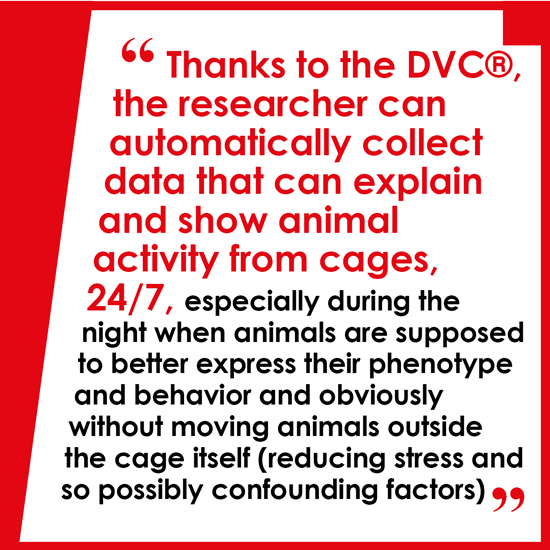
The current version of the Tecniplast website doesn't match your region. Please visit your local website to find information and offerings specific to your country.

The current version of the Tecniplast website doesn't match your region. Please visit your local website to find information and offerings specific to your country.

Author of the article “Towards large scale automated cage monitoring - Diurnal rhythm and impact of interventions on in-cage activity of C57BL/6J mice recorded 24/7 with a non-disrupting capacitive-based technique”
 Dear Dr Raspa, you are one of the authors of the article entitled “Towards large scale automated cage monitoring – Diurnal rhythm and impact of interventions on in-cage activity of C57BL/6J mice recorded 24/7 with a non-disrupting capacitive based technique”. This article has been recently published on PLOS One, a peer-reviewed open access scientific journal. Can you tell our readers the objective of the study and the conclusions?
Dear Dr Raspa, you are one of the authors of the article entitled “Towards large scale automated cage monitoring – Diurnal rhythm and impact of interventions on in-cage activity of C57BL/6J mice recorded 24/7 with a non-disrupting capacitive based technique”. This article has been recently published on PLOS One, a peer-reviewed open access scientific journal. Can you tell our readers the objective of the study and the conclusions?
This was a nice journey and we had wanted to improve experimental reproducibility by automated recording laboratory animal home cage behavior and drawing attention to non-intrusive surveillance not otherwise achievable by using conventional controls. The DVC® system correctly detected an increase and decrease in activity due to lights-on. We also documented impact on mouse activity that standard animal handling procedures have, e.g. cage-changes, and show that such procedures are stressors impacting in-cage activity. These key observations robustly replicated across three international test-sites (JAX, KI and CNR).
Can you list the added value of the DVC® technology in the study?
The DVC® technology is simply extraordinary and thanks to it we have implemented a 24/7, scalable activity monitoring system, based on recording perturbations in capacitance measurements. The sensors used by DVC® are placed outside and under the cage and reflect animal motion across the home cage floor.
The data generated allow us to provide accurate meaningful surveillance of cage-life, leading to improved animal welfare measures and experimental/testing study design and analyses.
Can you tell us the new boundaries in the research with the DVC® system? Is it a real revolution?
I have personally and enthusiastically been involved since the early stages of the project (2013), it seems to be a disruptive technology completing the IVC system that was introduced successfully some years before.

Thanks to the DVC® system, the researcher can automatically collect data that can explain and show animal activity from cages, 24/7, especially during the night when animals are supposed to better express their phenotype and behavior and obviously without moving animals outside the cage itself (reducing stress and so possibly confounding factors).
Do you think that PIs will have an added value with the data collected through the DVC system? Why?
PIs will be more than happy to have DVC®s as an added value in their research projects, enhancing reliability, robustness and reproducibility of experimental studies with the great advantage of collecting data 24/7.
Which Research applications will have a major impact with the new DVC® technology?
Many, I believe and mostly coming from the management of the cage itself by detecting overall cage animal activity to the experimental pattern, detecting phenotype and behavior. The DVC® system complements their experiments with locomotor animal activities directly from true home-cages without disturbing the animals and drastically increasing the potential sample size. This functionality can be easily applied to experiments where the researcher wants to see if animals are recovering/expressing phenotypes from a specific situation (i.e. circadian rhythms, surgery, induced pathology) or are quickly affected in the locomotor activity by a specific provided compound/task such as response to procedures (bedding change, lights on, etc.).
Would you suggest adopting this technology? For which applications and why?
This system harbors an as yet unforeseen potentiality; however, considering the information we have, I may suggest implementing DVC® to study all experimental genomic/epigenomic projects linked to neurological, locomotory and behavioral phenotypes of animals. This will also complete the pattern of international large-scale, standardised platform studies of new GEM mutant models of disease (International Mouse Phenotyping Consortium, etc.).
Where do you see the DVC® technology in 10 years?
It seems to me very similar to IVCs evolution, which is now in worldwide use. This may be a disruptive technology to be adopted in most infrastructures with mutual benefits both for facility management and science.
CLICK HERE TO DOWNLOAD THE FULL ARTICLE!
Giorgio Rosati – Digilab Marketing Manager